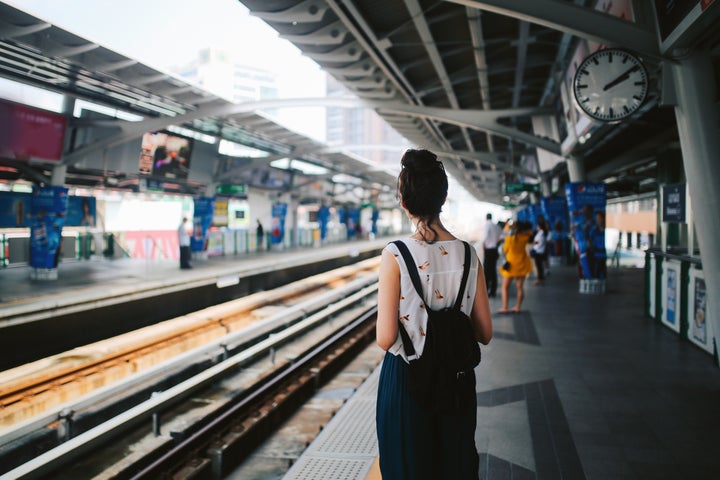
Our new research confirms what many of us already knew: upskirt videos are easily and freely available on mainstream pornography websites. Over a period of just six months, we found close to 2,500 videos on the landing pages of the UK’s top three most accessed porn sites, depicting acts that can be classed as forms of image-based sexual abuse.
Importantly, these titles were on the very front page of mainstream sites, freely and easily accessible for a first-time user. They are not hidden, only findable with specific search terms; nor are they relegated to a niche specialist site in some dark corner of the internet. These are videos depicting hidden cameras in women’s toilets and changing rooms, “spy cam” recordings of women on the beach, as well as videos showing both upskirting and downblousing.
Focusing on upskirting in particular, the sheer variety of named locations in the titles of the videos is testament to the reality that no public place is free from the risk of upskirt images being taken without consent. The titles ranged from ‘Sexy up-skirt in public bar in Hollywood’, to ‘Upskirted While Putting Groceries In The Car’, ‘Upskirted in the train’, ‘Upskirt under table’, and more locations, including: ‘supermarket’, ‘subway’, ‘busstop’, ‘busy street’, ‘taxi’, ‘bus station’, ‘dutyfree’, ‘mall’, ‘kitchen’, ‘changing room’, ‘woods’, ‘Oktoberfest’, ‘at work’, ‘on the stairs’, ‘gas station’, ‘gardening’, ‘fast food’, ‘public transport’, ‘coffee shop’, ‘school upskirt’, ‘anime convention’, ‘shoe shop’ and ‘café’.
Though some of these videos may be staged to appear non-consensual, they are all explicitly labeled for the viewer as ‘upskirt’ images - that is videos that are defined by their non-consensual nature. As images on pornography sites are there primarily for sexual arousal, this means that such videos, even if simulated, are contributing to a cultural landscape where men are encouraged to seek sexual gratification from women’s non-consent.
These videos also contribute to a context where the taking and sharing of private sexual videos is seen as a legitimate sexual practice, rather than a form of sexual violence. This both undermines the seriousness of the newly proposed upskirting criminal offence, as well as potentially increasing its perpetration by its normalization and minimization. The fact such titles were clear and present on the very first page of the most mainstream porn sites means that these kinds of disturbing messages are communicated to all visitors to those sites, not just the ones who choose to click on, or search for, this kind of content.
This research shows the need for action criminalizing all forms of the taking and sharing of non-consensual private, sexual images – including upskirting. We know from victim-survivors that their intimate images often end up on porn sites, viewed thousands of times and seriously amplifying the harms they experience. Making things worse, once uploaded to porn sites, getting them taken down from all sites is extremely difficult.
All of this is running counter to the Government’s efforts to recognise the harms of upskirting and criminalize the activity. The Voyeurism Bill, currently being debated in the House of Lords, only covers some forms of upskirting, where it can be proven that the perpetrator did so for the purposes of sexual gratification or to cause distress. This means, in particular, that it excludes where videos are recorded for entertainment, group bonding, for a ‘laugh’ among a group of friends.
Distributing videos without consent is also not clearly covered. Taking images with the plan to upload to a porn site will be covered, though taking them to share among friends is only criminalized if it can be proven this was done to cause distress to a specific victim. But often the perpetrators do not know who the victims are – nor do they care. The other possible law – often referred to as the ‘revenge porn’ law – is also limited as it only covers distributing images with the aim of causing distress to a victim. Perhaps other communications offences could be used – but this just shows the law is unclear and complex: exactly what deters victims, complicates investigations, and raises the threshold for prosecutions.
The Voyeurism Bill, while laudable, is already limited. Our research is showing that upskirting is not perpetrated by those on the margins, odd men that none of us know who have extreme and unusual sexual preferences. It’s not directly targeted at specific women. But in fact it’s commonplace and it’s being normalised. These videos are being taken everywhere. And even when simulated, they are legitimating a practice which is harmful to women, a gross invasion of privacy, and experienced as a sexual assault.
The Government can and must do more. It can adopt the recommendations put forward by Maria Miller MP and others, and take on board the comments and recommendations of many members of the House of Lords including Baroness Barran who raised the analogy with the Protection of Harassment Act. It can also ensure that these issues are covered in compulsory Relationships & Sex Education.
The Voyeurism Bill presents an opportunity to make it clear that the non-consensual taking and/or distribution of upskirt images is unlawful, regardless of the perpetrators’ motivation. Let’s focus on the harms to victims, and not the motives of perpretrators. This would be a first step towards a comprehensive legal regime challenging all forms of image-based sexual abuse and countering the message of the most mainstream porn sites that upskirting, and other forms of image-based sexual abuse, are legitimate sources of sexual arousal.